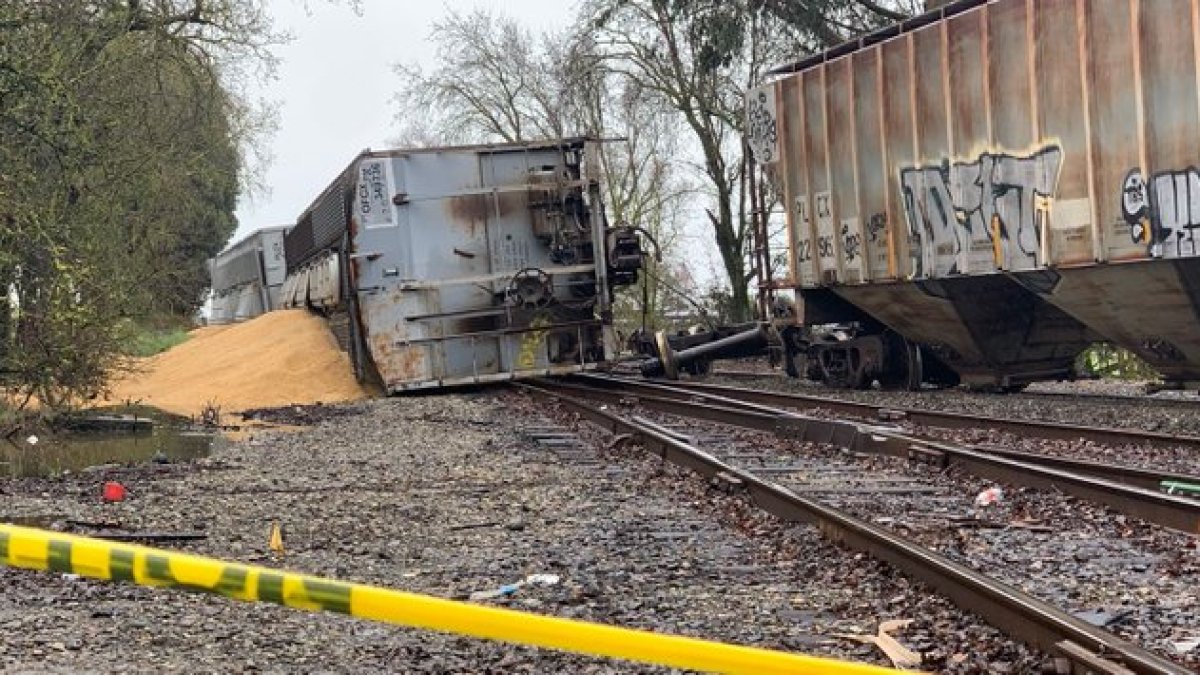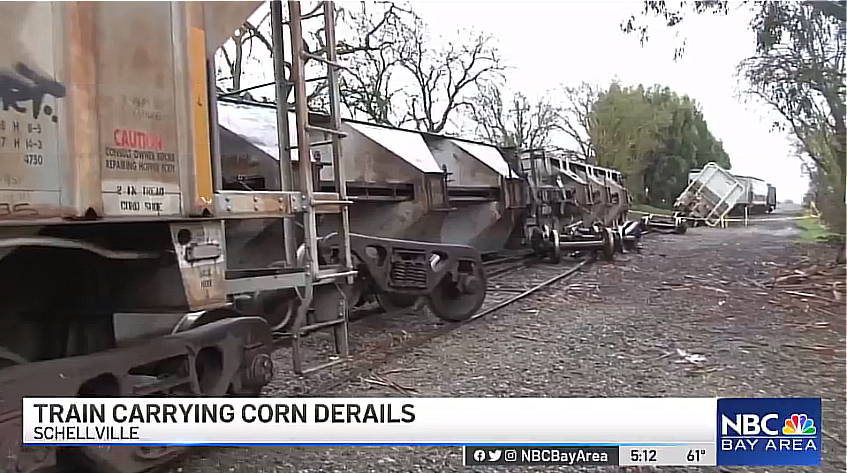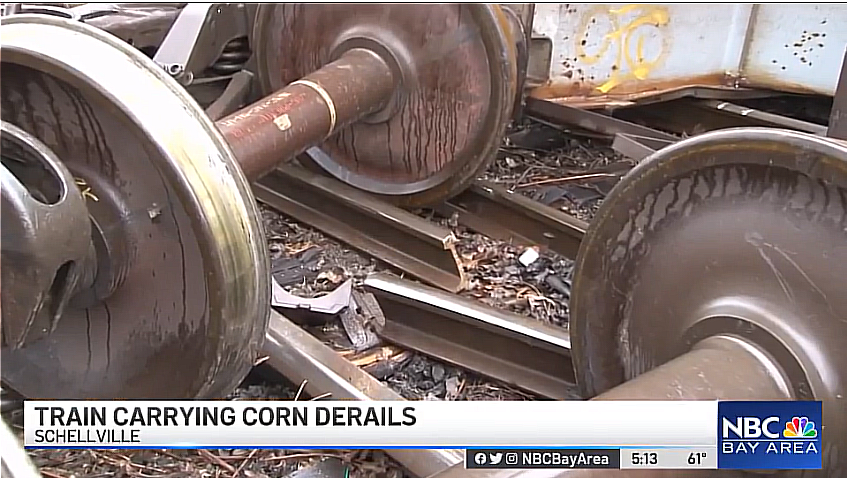Me just trying to better visualize and understand the steps and movements of a train going out on a oar dock and moving cars around out there. I'm sure its well choreographed and fairly straightforward if you've done it as a job or maybe even if you've seen it firsthand. I'm also unsure on what a 1000 foot lake freighter can carry however I believe one of the articles I posted said a modern jennie can haul 75 tons though if I read it correctly?Not sure what you're asking.
Take a look at the dock from above. Maybe that'll answer your question?
There are double tracks out to the dock.
There is a switch between the double tracks before it goes out over the water.
In the video, the train pulled the cars up to the switch, dropped them there, switched over to the other track and went to the far end of the train.
My guess would be that they then pushed the Jennies out onto the dock as far as the ship is long, dumped the contents of those Jennie into the corresponding hoppers, then pushed it out further out onto the dock and repeated.
If they got to a point where they still had more Jennies to dump than the dock is long, they'd break the train, pull the empties off onto the other track, and then push the remaining full Jennies out onto the dock.
See screen shots below.
The switch
View attachment 789018
The dock used to be 4 tracks wide, but looks to be 3 now.
View attachment 789019
The hoppers under the tracks with the chutes to dump into the ship.
View attachment 789020
The entire length of the dock compared to the ship.
View attachment 789021
You are using an out of date browser. It may not display this or other websites correctly.
You should upgrade or use an alternative browser.
You should upgrade or use an alternative browser.
Working rail roads and their tracks.
- Thread starter ArlyA
- Start date
- Views: 597812
More options
Who Replied?
/ Working rail roads and their tracks.
#2,571
My dad was a demolitions officer in WWII. I have his Army field manual on blowing things up. In the RR section it talks about frogs and where to place the charges for maximum damage with minimum materials. I read it around 12 years old, I believe.
I did not know how it got its name. Thanks!
Bruce
ArlyA
Super Star Member
- Joined
- Mar 18, 2016
- Messages
- 13,353
- Tractor
- Outlander1000 6x6, Ego lawn mower and shopping for tractor
This is how coal dust is reduced and might have to do with fire reduction as well.
Hay Dude
Epic Contributor
- Joined
- Aug 28, 2012
- Messages
- 25,256
- Location
- A Hay Field along the PA/DE border
- Tractor
- Challenger MT655E, Massey Ferguson 7495, Challenger MT535B, Krone 4x4 XC baler, (2) Kubota ZD331’s, 2020 Ram 5500 Cummins 4x4, IH 7500 4x4 dump truck, Kaufman 35’ tandem 19 ton trailer, Deere CX-15, Pottinger Hay mowers
Coal is as dead as nuclear power in this country now. Won’t be much use for them in 5 years
I remember visiting a coal fired power plant apologies for drift, anyways they were running bulldozers on the coal piles along with spraying them, to constantly turn and shape them in the middle of summer and to help prevent spontaneous combustion it does exist.This is how coal dust is reduced and might have to do with fire reduction as well.
ArlyA
Super Star Member
- Joined
- Mar 18, 2016
- Messages
- 13,353
- Tractor
- Outlander1000 6x6, Ego lawn mower and shopping for tractor
UP working in the snow near Rawlins WY a few days ago.
--------------------------------------------------------------
Winter isn't giving up just yet, and neither are Union Pacific's crews. Here's more massive snowdrifts that Team UP is battling, this time in Wyoming.



--------------------------------------------------------------
Winter isn't giving up just yet, and neither are Union Pacific's crews. Here's more massive snowdrifts that Team UP is battling, this time in Wyoming.
oliver1555
Gold Member
It’s amazing what the wind can do with snow!
California
Super Star Member
- Joined
- Jan 22, 2004
- Messages
- 16,596
- Location
- An hour north of San Francisco
- Tractor
- Yanmar YM240 Yanmar YM186D
I haven't been following this thread. But I was just reading something local, that someone here might find interesting:
It's a business case study for planning the resumption of freight traffic north of San Francisco. Railroad infrastructure still exists, but with near-zero freight. Passenger rail after being gone for decades, was resumed in the last few years by SMART - Sonoma Marin Area Transit - who now owns the track. It looks to be presently some 40 miles of passenger service on maybe 120 miles of track owned, but at a glance I didn't see the actual numbers. This business study examines generating more freight revenue running over the commuter rail that is maintained to high - passenger - standards, and beyond, on existing rail.
The first thing I noticed is to ship anything out of the area, Union Pacific, a class 1 line that SMART connects to, has absolute control over all pricing and customer contact with rail customers beyond this little world. UP prefers Unit Trains, marketed to the largest customers, hauling the same product in every car of a long train, between only two specific points. The pricing that UP negotiates while representing these connecting small lines, is so high for single carloads etc to random destinations, that these small connecting lines can't beat truck freight rates.
A surprising part of SMART's freight revenue is simply for parking others' idle railcars on their unused trackage.
I was surprised at the tiny freight revenue earned presently, and the little that might be earned if more local customers installed sidings to use rail. Most of the figures in the report are around $1m which seems so small that any trucking company could be more profitable.
Looks like SMART's freight service in the North Bay isn't likely to ever expand much.
It's a business case study for planning the resumption of freight traffic north of San Francisco. Railroad infrastructure still exists, but with near-zero freight. Passenger rail after being gone for decades, was resumed in the last few years by SMART - Sonoma Marin Area Transit - who now owns the track. It looks to be presently some 40 miles of passenger service on maybe 120 miles of track owned, but at a glance I didn't see the actual numbers. This business study examines generating more freight revenue running over the commuter rail that is maintained to high - passenger - standards, and beyond, on existing rail.
The first thing I noticed is to ship anything out of the area, Union Pacific, a class 1 line that SMART connects to, has absolute control over all pricing and customer contact with rail customers beyond this little world. UP prefers Unit Trains, marketed to the largest customers, hauling the same product in every car of a long train, between only two specific points. The pricing that UP negotiates while representing these connecting small lines, is so high for single carloads etc to random destinations, that these small connecting lines can't beat truck freight rates.
A surprising part of SMART's freight revenue is simply for parking others' idle railcars on their unused trackage.
I was surprised at the tiny freight revenue earned presently, and the little that might be earned if more local customers installed sidings to use rail. Most of the figures in the report are around $1m which seems so small that any trucking company could be more profitable.
Looks like SMART's freight service in the North Bay isn't likely to ever expand much.
Last edited:
Hay Dude
Epic Contributor
- Joined
- Aug 28, 2012
- Messages
- 25,256
- Location
- A Hay Field along the PA/DE border
- Tractor
- Challenger MT655E, Massey Ferguson 7495, Challenger MT535B, Krone 4x4 XC baler, (2) Kubota ZD331’s, 2020 Ram 5500 Cummins 4x4, IH 7500 4x4 dump truck, Kaufman 35’ tandem 19 ton trailer, Deere CX-15, Pottinger Hay mowers
I haven't been following this thread. But I was just reading something local, that someone here might find interesting:
It's a business case study for planning the resumption of freight traffic north of San Francisco. Railroad infrastructure still exists, but with near-zero freight. Passenger rail after being gone for decades, was resumed in the last few years by SMART - Sonoma Marin Area Transit - who now owns the track. It looks to be presently some 40 miles of passenger service on maybe 120 miles of track owned, but at a glance I didn't see the actual numbers. This business study examines generating more freight revenue running over the commuter rail that is maintained to high - passenger - standards, and beyond, on existing rail.
The first thing I noticed is to ship anything out of the area, Union Pacific, a class 1 line that SMART connects to, has absolute control over all pricing and customer contact with rail customers beyond this little world. UP prefers Unit Trains, marketed to the largest customers, hauling the same product in every car of a long train, between only two specific points. The pricing that UP negotiates while representing these connecting small lines, is so high for single carloads etc to random destinations, that these small connecting lines can't beat truck freight rates.
A surprising part of SMART's freight revenue is simply for parking others' idle railcars on their unused trackage.
I was surprised at the tiny freight revenue earned presently, and the little that might be earned if more local customers installed sidings to use rail. Most of the figures in the report are around $1m which seems so small that any trucking company could be more profitable.
Looks like SMART's freight service in the North Bay isn't likely to ever expand much.
I live in a town full of small, unused sidings closed up with rusted cyclone fence. Meanwhile the loading docks for the trucks are being used. It’s a nation-wide thing in many areas.
The big advantage to trucking is companies can send anything under ~25 tons, anywhere by truck.
Rail is limited to going where there is rail and mucho rail has been put out of service or outright removed.
We have a mill in my area called “Lenape Forge”. It has a rail siding that goes behind the building and into the building. It hasn’t been used in probably 30 years. The company produces large aluminum castings. The rail line has freight service to the Port of Wilmington, DE or Philadelphia to ship products worldwide, yet it uses truck transportation. Could be because of price, or that buyers are only purchasing smaller items more easily handled by truck.
I kind of doubt we will ever see freight rail expansion ever in my lifetime in MY area, although East Penn has been doing quite a few improvements to existing active rails.
California
Super Star Member
- Joined
- Jan 22, 2004
- Messages
- 16,596
- Location
- An hour north of San Francisco
- Tractor
- Yanmar YM240 Yanmar YM186D
Here's what drew my attention to SMART recently. A news article said a couple of cars of feed grain flopped over while being moved slowly in their switching yard at Schelleville. (miles from their nearest passenger service). I found a railroader's discussion group saying lack of maintenance - based on their personal experience there - likely meant that rotten ties allowed the gauge to spread, dropping the car. Then continued pulling by the locomotive on a switch curve, pulled the cars over. Nobody injured.

 www.nbcbayarea.com
www.nbcbayarea.com
And here's a site with photos. Looks like something related to lack of roadbed maintenance could be the cause.
Maybe this belongs in Hauling Something Wrong.



I remember Schelleville because as a kid, before freeways, it was on the most direct route in the 100 mile trip to go visit grandparents. It's a couple of miles from the famous green hillside in Windows XP. Back then it was Southern Pacific's turnaround loop, the northern end of their San Francisco region service, where cars were handed off to Northwestern Pacific RR for the 300 mile run up to the NW California lumber mills.
Northwestern Pacific was more recently owned by a private investor who seemed to use it as a front for sucking federal and state subsidies to pocket for himself, instead of using the taxpayer funds to re-open fallen tunnels and replace track buried by landslides. I had a minor role in reviewing that owner's costs claimed for reimbursement. I see in the Wikipedia article that now, everything is abandoned with some of the locomotives and cars trapped in discontinous sections of the mountainous R of W, north of the section sold to SMART.

No Injuries Reported After Train Carrying Corn Derails in Sonoma County
Authorities are investigating a train derailment that happened in Sonoma County Thursday.
 www.nbcbayarea.com
www.nbcbayarea.com
And here's a site with photos. Looks like something related to lack of roadbed maintenance could be the cause.
Maybe this belongs in Hauling Something Wrong.



I remember Schelleville because as a kid, before freeways, it was on the most direct route in the 100 mile trip to go visit grandparents. It's a couple of miles from the famous green hillside in Windows XP. Back then it was Southern Pacific's turnaround loop, the northern end of their San Francisco region service, where cars were handed off to Northwestern Pacific RR for the 300 mile run up to the NW California lumber mills.
Northwestern Pacific was more recently owned by a private investor who seemed to use it as a front for sucking federal and state subsidies to pocket for himself, instead of using the taxpayer funds to re-open fallen tunnels and replace track buried by landslides. I had a minor role in reviewing that owner's costs claimed for reimbursement. I see in the Wikipedia article that now, everything is abandoned with some of the locomotives and cars trapped in discontinous sections of the mountainous R of W, north of the section sold to SMART.
